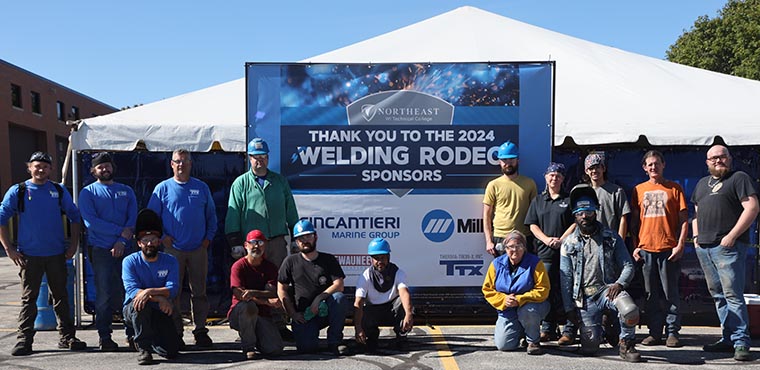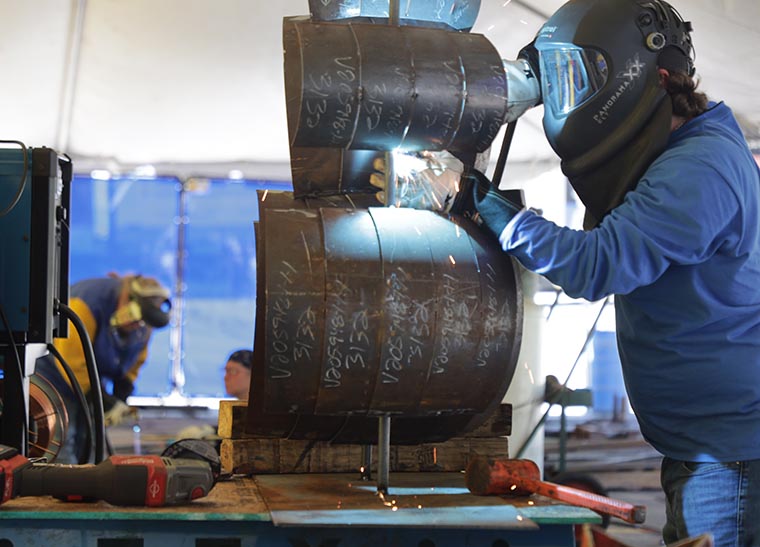
Welding Rodeo
Get ready for NWTC's Welding Rodeo, an exciting event at our Marinette and Sturgeon Bay campuses that you won't want to miss! And the best part? It's completely FREE and open to everyone!
What to Expect at the Welding Rodeo
This event offers a full day of thrilling competition, hands-on activities, and community spirit. Come join the fun and support the future of welding!
Welding Competitions
- Who will have the skills to win? Watch as teams of up to 4 welders compete, using only donated scrap metal to create stunning sculptures in just 8 hours.
- Categories include amateur (high school & college), professional, and corporate team welders. Top teams will win amazing prizes!
STEM Career Fair
- Dive into the world of science, technology, engineering, and math!
- Connect with local employers and NWTC staff to discover endless career opportunities in these booming fields.
Family Fun
- Enjoy a day of activities, mouthwatering food, and music for all ages!
Live Metal Sculpture Auction
- Don't miss your chance to own a piece of the competition! Sculptures created during the event will be sold to the highest bidder.
- All proceeds benefit scholarships for NWTC welding students.

Marinette Campus
Wednesday, October 1, 2025 | 8:00 a.m. to 5:00 p.m.
Sturgeon Bay Campus
Thursday, October 9, 2025 | 8:00 a.m. to 5:00 p.m.
More Event Details
Welding Rodeo Benefits
- Tests welding and fabricating skills in a unique learning experience
- Reinforces teamwork and leadership skills
- Incorporates tool and equipment safety as well as set-up training
- Requires troubleshooting skills
- Connects community, college, and industry
Employer Participation
If you are an employer interested in participating in our Career Fair, donating scrap metal and supplies, or becoming a sponsor, see our industry participation form.
During the STEM Career Fair at the Welding Rodeo, taking place from 11:30 a.m. to 2:30 p.m., employers can:
- Showcase your company
- Connect with talented students and job seekers interested in careers in science, technology, engineering, and mathematics, with a special focus on welding and skilled trades
- Inspire the next generation of professionals
Sculpture Auction Info
- Payment due at time of auction.
- We ask that the sculptures remain on campus at NWTC Sturgeon Bay for one week following the event.
- Maximum dimensions of each sculpture are 5 feet wide by 5 feet high by 5 feet deep.
- Winning bidders are responsible for picking up and transporting the sculptures by contacting Michelle Rutues, NWTC event coordinator, at michelle.rutues@nwtc.edu or 920-272-9459.
Questions?
Please contact Michelle Rutues. Email: michelle.rutues@nwtc.edu | Phone: 920-272-9459
The Welding Rodeo: Experiences in STEM Education is sponsored by the Department of Navy, Office of Naval Research under ONR award number N00014-24-1-2151. Any opinions, findings, and conclusions or recommendations expressed in this material are those of the author and do not necessarily reflect the views of the Office of Naval Research.